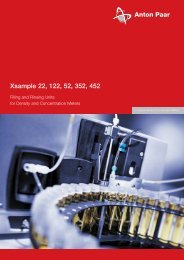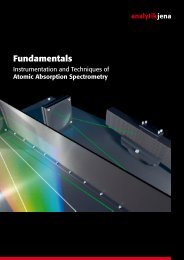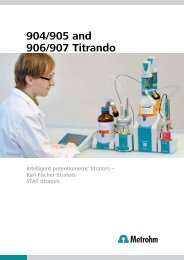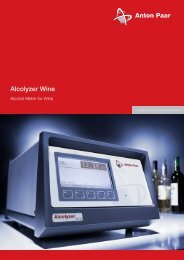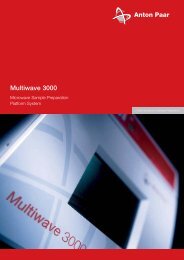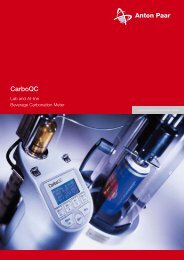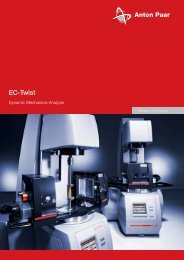Solutions for Nanotechnology - MEP Instruments
Solutions for Nanotechnology - MEP Instruments
Solutions for Nanotechnology - MEP Instruments
- No tags were found...
Create successful ePaper yourself
Turn your PDF publications into a flip-book with our unique Google optimized e-Paper software.
<strong>Solutions</strong> <strong>for</strong><strong>Nanotechnology</strong>
Focusing on solutionsAnton Paar has been developing, producing anddistributing high-precision measuring and analyticalinstrumentation <strong>for</strong> laboratory and processapplications since 1922.The company understands that preparing,synthesizing and investigating nanomaterialsrequires know-how and technology at the cuttingedge, instruments with outstanding precision andreproducibility.To meet these needs, Anton Paar providesinstruments realized with a passion <strong>for</strong> precision,a love of science, and a shared enthusiasm in theentire chain of production, every step of the way.
IntroductionDefinition 4<strong>Nanotechnology</strong> 5Nanomanufacturing 7Nanomedicine 8How can you precisely determine the size distribution of nanodrugs? 9How can you find the required magnetorheological fluid? 10How can you secure drinking water quality? 11What are smart coatings? 12How does controlled drug delivery work? 13“Nano” in Everyday Products 14How can nanotechnology help you tune glue? 15How does rheometry help to develop the perfect “crema“ and foam? 16Do nanoparticles influence the liquid-crystalline structure of soap? 17Are nanoparticles the solution <strong>for</strong> af<strong>for</strong>dable electric cars? 18How can you optimize microemulsions? 19Nano-electrotechnology 20Why do you need a density meter <strong>for</strong> the production of solar cells? 21How can you maximize your in<strong>for</strong>mation about polymer-carbon black? 22Why does the electronics industry investigate inks using a microviscometer? 23How can you obtain nanocrystalline zinc sulfide? 24How can you predict whether wafer cleaning will be successful? 25Nanochemistry 26How can you obtain crude oil out of “empty” sources? 27How do you design a polymer-nanocomposite with the properties you want? 28Are molecular sieves environmentally benign? 29How can you easily prepare uni<strong>for</strong>m nanoparticles? 30Are nanomaterials the solution <strong>for</strong> hydrogen storage? 31ProductsMonowave 300 – Monomode Microwave Synthesis Reactor 32MCR – The Modular Compact Rheometer Series 32Masterwave BTR – Large-Scale Microwave Synthesis 33Synthos 3000 – Multimode Microwave Reaction System 33DMA 5000 M – Density Meter 33Lovis 2000 M/ME – Microviscometer 34SurPASS – Electrokinetic Analyzer <strong>for</strong> Solid Samples 34SAXSess mc² – Modular Tool <strong>for</strong> Nanostructure Analysis 35XRK 900 / HPC 900 – Non-ambient XRD Attachments 35Abbemat – Refractometer Series 35
4DefinitionThe size range from 1 nm (nanometer) to 100 nm is called “nanoscale”.Materials which are composed of one or more interrelated constituentparts in the nanometer size range are referred to as nanomaterials.Nanomaterials can have many different morphologies: there are nanoparticles,nanofibers, nanowires, nanoplates, nanobelts, nanotubes and many more.Some of them are nanosized in only one dimension (nanoplates, nano-surfacecoatings), some in two dimensions (nanofibers, nanowires and nanotubes) andsome in all three dimensions (nanoparticles).What is special about nanomaterials?When a particle becomes smaller, its surface becomes bigger relative to itsvolume, thus changing the overall properties of the resulting nanomaterial. Itmay be more reactive, have different optical, magnetic and electrical behavior,be mechanically stronger or more toxic compared to the same material on alarger scale. One major reason <strong>for</strong> these changes is that nanomaterials break asize barrier below which quantum effects can begin to dominate their behavior.How big is one nanometer?The following table illustrates the size of one nanometer:Width (diameter) Example1 nm Carbon nanotube Ratio tennis ball / 1 nm6.5 x 10 7 nm Tennis ball6.5 x 10 72.2 x 10 8 nm FootballRatio earth / football1.3 x 10 16 nm Earth5.9 x 10 7For a deeper understanding and tuning of nanomaterial properties, thenanostructure is of utmost importance. Nanostructures can either <strong>for</strong>m in thebulk material or on the surface. Often they <strong>for</strong>m naturally due to intermolecular<strong>for</strong>ces. Knowledge of these processes is, however, invaluable <strong>for</strong> tailor-makingtechnical materials. X-ray scattering, more specifically small-angle X-rayscattering (SAXS), is the technique of choice <strong>for</strong> nanostructure analysis.
6Microemulsions based on nanoscale structures are clear or translucent incontrast to emulsions containing micrometer-sized structures, which are cloudy.Microemulsions are widely used in the pharmaceutical and cosmetics industries,<strong>for</strong> example as drug delivery systems and <strong>for</strong> reduced-fat food products suchas low-fat mayonnaise.Nanosuspensions, which are colloidal suspensions of nanoscale particlesstabilized by surfactants, are mainly used to improve the solubility of poorlywater-soluble drugs. Nanofoams are investigated <strong>for</strong> use as cheap andefficient insulator materials. Their properties can differ remarkably from thebulk materials, e.g. carbon nanofoam shows ferromagnetic behavior, which isunusual <strong>for</strong> carbon material. Properties of dispersions and their interfaces orsurfaces can be determined via rheological measurements.Stability of dispersionsThe stability and behavior of dispersions, irrespective of the size range ofthe dispersed particles, are based on surface <strong>for</strong>ces between the dispersedparticles. Surface <strong>for</strong>ces depend on particle-size distribution, pH, temperature,type and concentration of stabilizing additives. Stabilization based on repulsionbetween the dispersed particles is achieved by adsorbed or grafted non-ionicsurfactants or polymer layers on the particles (steric stabilization) or surfacecharges (electrostatic stabilization). Electrostatically stabilized dispersions aresensitive to the addition of electrolytes; sterically stabilized dispersions aresensitive to mechanical <strong>for</strong>ces and temperature.Studies on the influence of mechanical <strong>for</strong>ces, e.g. shear on the behavior ofdispersions, is essential in many application fields. Some dispersions showthixotropic behavior: the viscosity changes at a given shear rate but returns toits initial value after removing the shear. These characteristics allow importantapplications in paints, cosmetics and food science and can be investigatedusing rheometry.Nanostructured surfacesOne-dimensional nanomaterials, such as thin films, layers and surface coatings,are widely used, often in the production of electronic devices. Monolayers,which are layers consisting of one layer of atoms or molecules, are alreadyroutinely produced and applied in many fields of modern chemistry. Surfaceswith tailored properties, such as a large surface area or specific reactivity, areutilized <strong>for</strong> fuel cells and catalysts.
7One example of an outstanding property of a nanostructured surface is“the lotus effect”. The leaves of the lotus flower repel water efficiently. Wateradhesion is decreased due to the microscopic and nanoscopic architectureof the surface. The plant surface has a first layer of papillae in the microscalerange which reduces the contact area, and a second layer of nanoscalehydrophobic waxes. If water droplets roll off the leaf, the adhesion betweena dirt particle and a water droplet is higher than between the particle and thesurface, resulting in a cleaning effect. The lotus effect is used in nanotechnology<strong>for</strong> self-cleaning windows, mirrors, clothes and many other surfaces. Surfaceproperties and their pH-dependent changes can be investigated via zetapotential measurements.NanomanufacturingNanomaterials can be prepared using the top-down or bottom-up method.The “top-down method” breaks down larger sized chemical compounds intonanosized materials. However, the major approach, high-energy ball milling,suffers from contamination problems, and results in a highly polydisperse sizedistribution of the obtained nanoparticles. Nevertheless, this technique is usedto generate different kinds of nanoparticles and is sufficient <strong>for</strong> some commonapplications.The “bottom-up method” uses specific synthesis techniques that allow controlof the <strong>for</strong>mation of nanoscale materials. The two main techniques are sol-gelprocessing and gas phase synthesis. The sol-gel process is a wet-chemicaltechnique in which hydrolysis and subsequent polymerization reactionsresult in dimers, trimers and finally polymers until particles can be observed.The production of nanoparticles via gas phase synthesis is based on anoversaturated vapor which is obtained either by a chemical reaction or by achange of ambient conditions. If the vapor is saturated enough, a seed crystalcan <strong>for</strong>m which grows and results in a particle.One big issue in nanomaterial synthesis is the possibility of tuning the physicaland chemical properties by varying the crystal size and shape. Zinc sulfide,which is one of the most important semiconductors, can be produced withdifferent crystallite sizes depending on the reactant concentrations and theapplied heating method (conventional or microwave-assisted). Besides ashorter reaction time the greatest advantage of using microwave irradiationis that it allows exact control of reaction conditions to tailor the resultingnanoparticles according to requirements. The structural characterization of theobtained nanoparticles (size and size distribution, shape) can be per<strong>for</strong>medusing small-angle X-ray scattering (SAXS).
8NanomedicineNanomedicine is the field that uses nanotechnology in medicalapplications.Living organisms are built up of cells which are usually in the size range ofaround 10 µm. Cell parts are built up of proteins which are in the nanometersize range. This is the same size range as various nanoparticles applied inmedicine.Nanocrystalline silver is already widely used in medicine: it is mainly applied asan antimicrobial agent <strong>for</strong> the treatment of wounds.Another promising application of nanostructures is their use as colloidal deliverysystems. They transport drugs directly to diseased cells in the body, solving thepronounced solubility problems of potentially useful drugs. Under investigationis also the delivery of genetic material to specific cell types to either inhibit theexpression of a specific gene or to express therapeutic proteins.<strong>Nanotechnology</strong> has also found its way into biological diagnostics. Nanocrystalscan be used as fluorescent probes in biological staining and diagnostics, withthe advantages of a narrow, tunable, symmetric emission spectrum and ahigher photochemical stability compared to conventional fluorophores.Further, nanomaterials are used in the biodetection of pathogens, and <strong>for</strong> theseparation and purification of biological molecules and cells. Nanosized agents,<strong>for</strong> example, can be used to enhance the magnetic resonance (MR) imagingcontrast in a more efficient way compared to common agents.Among the most promising projects <strong>for</strong> further applications of nanotechnologyin medicine are nanoshells that concentrate heat from IR light to destroy cancercells, nanotubes applied to broken bones to provide structural support <strong>for</strong>new bone material and nanoparticles that can attach to cells and identify theparticular disease in, <strong>for</strong> example, a blood sample.Cryo-transmissionelectron microscopeimage of multilamellarliposomes. Image: GrazCentre <strong>for</strong> ElectronMicroscopyThe applicability of nanotechnology in medicineis huge, as is the employment of Anton Paarinstruments in this area. A small selection ofapplications is shown on the following pages.200 nm
9How can you preciselydetermine the sizedistribution of nanodrugs?With the Abbemat refractometer the refractive index ofnanocrystals and nanoparticles can be reliably and preciselydetermined in order to analyze laser diffraction data.Nanoparticles and nanocrystals are widely used in pharmaceuticalsand cosmetics. The size distribution of these nanodrugs stronglyinfluences their chemical and biological behavior and theassociated effectiveness. It is there<strong>for</strong>e a highly requesteddeterminant.The size of nanoparticles or nanocrystals can beinvestigated employing laser diffraction. The sizedistribution is calculated from the diffraction pattern. Forthis calculation the refractive index of the nanoparticlesneeds to be exactly known at the laser wavelengthused. However, the refractive index is often taken withoutmeasurement, leading to inaccurate results.Due to the solubility of the nanoparticles and crystals the refractiveindex has to be measured at low concentrations and then isextrapolated to the pure substance. Using Anton Paar’s Abbematrefractometer the refractive index can be measured highly accurately,which minimizes extrapolation errors. The Abbemat multiple wavelengthmodel provides the possibility to choose the wavelengths of the laser beams.Click here <strong>for</strong> the Application Flash on this topic.Abbemat refractometer
10How can you find the requiredmagnetorheological fluid?Valuable in<strong>for</strong>mation about the behavior of magnetorheologicalfluids under the influence of a magnetic field is gained byrheological measurements.A thorough characterization of magnetorheological fluid (MRF)properties is essential <strong>for</strong> choosing the right fluid to suitthe application, as well as <strong>for</strong> optimizing MRFs <strong>for</strong> furtherimplementation.Magnetorheological fluids are suspensions of particleswhich can be magnetized. They exhibit fast, strong andreversible changes in their rheological properties when amagnetic field is applied, making them very interesting <strong>for</strong>many technical applications such as semi-active humanprosthetic legs. The introduction of nano-MRFs has nowsolved the problem of sedimentation.Data concerning field-induced changes of fluid viscosity <strong>for</strong>a broad range of shear rates, viscoelastic properties and yieldstress can be obtained using an MCR rheometer together with theMagneto-Rheological Device.Click here <strong>for</strong> the Application Report on this topic.MCR rheometer and MRD
11How can you securedrinking water quality?The charging behavior of inner and outer membranesurfaces can be investigated using the SurPASSelectrokinetic analyzer.The zeta potential gives comprehensive in<strong>for</strong>mation about the chargingbehavior inside pores of ceramic filters made of diatomaceous earth.Ceramic filters are commonly used <strong>for</strong> ground water filtration toeffectively remove bacteria. Viruses are 100 times smaller thanbacteria and the pore size of ceramic filters is usually too bigto ensure complete removal. Besides pore size the surfacecharge is an important filter parameter.At the pH of surface and ground water viruses arenegatively charged. If ceramic membranes are modifiedwith a heavy metal oxide a positive surface charge can beobtained. The negatively charged virus particles can then besuccessfully filtered due to their electrostatic attraction to themembrane pore walls. The SurPASS instrument helps to predict thefiltration properties of modified membranes.Click here <strong>for</strong> the Application Report on this topic.SurPASS
12What are smartcoatings?Zeta potential measurement assists in tailoring theproperties of technical and biomedical surfaces.Self-assembled monolayers (SAMs) are <strong>for</strong>med when amphiphilicmolecules, such as surfactants or silanes, adsorb as amonomolecular layer on surfaces. Nanoscale coatings of organicsilanes or thiols with functional end-groups are a smart procedureto tune material surface properties without changing thematerial thickness.The major application fields of SAMs are the control ofwetting and adhesion, the improvement of chemicalresistance and bio-compatibility and molecular recognition.Alkane thiol-anchored self-assembled monolayers on goldare widely used to immobilize and detect molecules, includingDNA, which become covalently bonded to the SAM on the goldsurface. To improve the selectivity of the SAM coating, the surfacecharge, measurable by SurPASS, can be tailored by adding differentfunctional end-groups.Click here <strong>for</strong> the Application Report on this topic.SurPASS
13How does controlleddrug delivery work?SAXSess mc 2 provides the possibility of time-resolvedsmall-angle X-ray scattering experiments.The potential application of micelles as vehicles <strong>for</strong> the deliveryand sustained release of active ingredients such as drugs can bedetermined by following their structure changes over a long periodof time.Dispersions with liquid-crystalline nanosized substructuresare of great importance in numerous scientific and industrialapplications. These systems exhibit nanostructures witha high interfacial area, low viscosity and the capabilityto solubilize various molecules. They are importantas membrane mimetic matrices, as vehicles <strong>for</strong> activeingredients and as unique microenvironments <strong>for</strong> thecontrolled release of additives such as drugs.Substructured emulsions can be investigated with the SAXSess mc 2in the time-resolved mode in order to study the kinetics of transportprocesses.Click here <strong>for</strong> the Application Report on this topic.SAXSess mc 2 and autosampler
14“Nano” in EverydayProductsNanosystems are all around you in daily life. Milk, mayonnaise,many detergents, paints, inks, shampoos and toothpaste are allcolloidal dispersions.The stability and properties of these products depend on surfactants whicheither occur naturally or are used as additives. Supplements like omega-3 fattyacids are often encapsulated in nanostructures to prevent food tasting fishy.Drinks which change their color and taste depending on whether they areshaken or stirred are currently under exploration. They contain nanocapsulesfull of different flavors and colors. Depending on the applied mechanical <strong>for</strong>ces,different capsules burst and release their contents.Recently, the inner walls of fridges have begun to be coated with nano-silver toinhibit bacterial growth and eliminate odors.Another important application field of nanostructures is the food packagingsector: Nanocomposites in packaging materials are used to extend the life offood and drinks by inhibiting bacterial growth or strengthening the barrier <strong>for</strong>carbon dioxide and oxygen. A possible future application is packaging whichchanges color when food begins to spoil or becomes contaminated withpathogens.Nanosized pesticides are better absorbed by plants, resulting in increasedeffectiveness of treatment. To improve genetic engineering breeding programs,nanostructures are investigated <strong>for</strong> delivering DNA and chemicals into plant andanimal cells and tissues.Nanosized zinc oxide particles are applied in transparent sunscreens. Cotton,synthetics, wool, silk, rayon and polypropylene are treated with nanoparticles toenhance their properties, such as spill control, fast drying and stain resistance.The utilization of nanotechnology in electrical energy stores, such as batteries,aims at improving their capacity and safety.Transmission electronmicroscope image ofcobalt iron oxide nanoparticles.Image: GrazCentre <strong>for</strong> ElectronMicroscopy<strong>Nanotechnology</strong> is already frequentlyapplied in everyday products. The followingapplications of Anton Paar instruments areonly a small selection of their use in this area.100 nm
15How can nanotechnologyhelp you tune glue?The Abbemat refractometer enables precise monitoring of thecuring process of glue containing nanoparticles.Epoxy resins are widely applied as glues <strong>for</strong> everyday products andalso <strong>for</strong> high-end applications, e.g. in the aircraft industry, the boatbuilding industry and the electronics industry.Nanoparticles are used to tailor-make glues suiting specificapplication needs. The addition of nanoparticles changesthe chemical, electrical, mechanical and surface propertiesof glues. The influence on the curing behavior can bedetermined with a refractometer.The phase transition during the hardening process of gluesmanifests itself in a change of refractive index. Anton Paar’sAbbemat refractometer enables monitoring of the refractiveindex during curing without being influenced by the volumechange. After curing the sample can be easily removed fromthe scratch-proof prism surface.Click here <strong>for</strong> the Application Flash on this topic.Abbemat refractometer
16How does rheometry helpto develop the perfect“crema“ and foam?Interfacial shear rheology employing an MCR rheometer is a verysensitive technique <strong>for</strong> the investigation of foam and emulsion stability.The stability of food products in the <strong>for</strong>m of emulsions or foamsis dependent on interfacial properties, which play a major role inpreventing the coalescence of emulsions or film drainage of foams.Surface-active additives adsorb at the air/liquid or liquid/liquidinterface, often building a monolayer with a thickness of onlya few nanometers. This interface can be investigated withan MCR rheometer, which provides in<strong>for</strong>mation on thedynamics of the film <strong>for</strong>mation as well as the rheologicalproperties of the final film.In the case of coffee, besides the initial film <strong>for</strong>mation and thestability of the final film, the thixotropic behavior is an importantparameter. The required in<strong>for</strong>mation can be easily obtained usingAnton Paar’s MCR rheometer plus Interfacial Rheology System.Click here <strong>for</strong> the first Application Reportor the second Application Report on this topic.MCR rheometer and IRS
17Do nanoparticles influencethe liquid-crystallinestructure of soap?The structure of micellar systems under varying conditions can beinvestigated via small-angle X-ray scattering (SAXS).Micelles are a classical example of nanostructures <strong>for</strong>med through theself-assembly of amphiphilic molecules in aqueous solvents. Themicellar size, shape and structure are dependent on parameterssuch as temperature, pH and the presence of ions.Triton ® X-100 is a common emulsifier agent mainly used indetergents. It is non-ionic (neutral) and one of the mostfrequently studied and exploited micellar systems. Toensure the required applicability, the behavior of Triton ®X-100 under changing conditions has to be investigated.The effect of temperature and the presence of macro-ions,such as small nanoparticles, on the structure of Triton ® X-100micelles can be elucidated using the SAXSess mc 2 small-angleX-ray scattering instrument from Anton Paar.Click here <strong>for</strong> the Application Report on this topic.SAXSess mc 2
18Are nanoparticles the solution<strong>for</strong> af<strong>for</strong>dable electric cars?Microwave-assisted synthesis simplifies thepreparation of tailored nanoparticles.Chemical syntheses are often per<strong>for</strong>med at elevated temperature,since it is commonly known that an increase in temperature results inshorter reaction times. Microwave reactors allow <strong>for</strong> rapid heatingfar beyond the boiling point of the applied solvent.To reduce the costs of lithium-ion batteries the automobileindustry has changed from using lithium cobalt oxide tousing less expensive lithium iron phosphate. However, thetypical iron phosphate manufacturing process takes hoursof baking at high temperatures, resulting in high costs dueto the extra work and energy required. Microwave heatingcan be used to speed up the synthesis process and savemoney.When producing lithium iron phosphate by applying a microwavereactor the reaction time can be significantly reduced from hoursdown to minutes.Click here <strong>for</strong> the Application Flashor the Application Report on this topic.Masterwave BTR
19How can you optimizemicroemulsions?The stability and behavior of microemulsions can be investigatedusing either small-angle X-ray scattering (with SAXSess mc 2 ) orrheometry.Knowledge of parameters such as flow behavior, “yield point”,structural regeneration and temperature dependence ofmicroemulsions is essential <strong>for</strong> the manufacturing process(homogenizing, pumping, filling) of microemulsions and <strong>for</strong>the design of end products such as gels and lotions withcustomized properties.Microemulsions are made of at least two immiscible fluidsplus a surfactant. High surfactant content influences theskin barrier and allows the active ingredients which aredissolved in the microemulsions to move through the skininto the organism.The MCR rheometers are well suited <strong>for</strong> quality control tasksin the cosmetics industry, such as monitoring the flow behavior,determination of the yield point and structural regeneration. Deeperknowledge about the contained nanosized structures can be obtainedemploying SAXSess mc 2 .Click here <strong>for</strong> the first Application Reportor the second Application Report on this topic.SAXSess mc 2
20Nano-electrotechnologyNano-electrotechnology defines a large area combiningnanostructured sensors, nanoelectronics, optoelectronics,magnetic materials and devices, radiofrequency devices,electrodes with nanostructured surfaces and many more.Typically, nano-based materials and devices are integrated into existingproducts or materials in order to make them more efficient or more effective.Inorganic semiconducting nanomaterials have become a popular field ofresearch owing to their variety of physical and chemical properties and theassociated wide range of possible applications. Some of these nanomaterialsare investigated <strong>for</strong> their applicability as future field emission devices used,<strong>for</strong> example, in displays. Compared to conventional methods, the applicationof nanostructures should result in a faster device turn-on time, increasedcompactness and higher sustainability.Electrodes made from nanowires would enable flat panel displays to be flexibleas well as thinner than common flat panel displays. Nanoscale electronicdevices can per<strong>for</strong>m as both switches and amplifiers, and should replacecommonly used transistors in the next generation of smaller, denser and fasterdigital computers. For this application, carbon nanotubes are of major interestas they enable the production of minimum size transistors.<strong>Nanotechnology</strong> further assists in producing memory chips with remarkablyincreased disk space. Nanoparticles are investigated <strong>for</strong> new developments inphotovoltaic systems, such as thin-layer solar cells, dye solar cells or polymersolar cells.Another important field of investigation is thermal energy storage. Employingnano-enabled microencapsulated phase change materials the efficiency can beincreased compared to conventional structures.Transmission electronmicroscope imageof cobalt iron oxidenanocrystals. Image:Graz Centre <strong>for</strong> ElectronMicroscopyThe field of nano-electrotechnology oftenoverlaps with other fields of nanotechnology.A selection of applications <strong>for</strong> Anton Paarinstruments is given on the following pages.60 nm
21Why do you need a densitymeter <strong>for</strong> the production ofsolar cells?Capable of detecting tiny changes in samplecomposition, the DMA 5000 M is the most accuratedensity meter on the market.A new technique referred to as silicon ink technology remarkablyreduces the production costs of solar cells. This technique is basedon a special ink that contains dispersed silicon nanoparticles.Conventional solar cell manufacturing lines can be optimized byadding a single silicon ink printing step which results in solarcells with higher conversion efficiency.The composition of this ink requires careful fine tuningas the final product has to be suitable <strong>for</strong> a variety ofindustrial printers such as screen printers or inkjet printers.Composition and viscosity are equally important factors inthe consistency of this ink. Anton Paar instruments are usedto optimize product quality and cost-efficiency at the same time.Combining Anton Paar’s DMA 5000 M density meter andLovis 2000 ME viscometer provides a system <strong>for</strong> measuring thedensity and viscosity of inks in one run. The easy and highly accuratedetermination of these parameters ensures the right ink composition <strong>for</strong>a variety of printing equipment.Click here <strong>for</strong> the Application Flash on this topic.DMA 5000 M
22How can you maximizeyour in<strong>for</strong>mation aboutpolymer-carbon black?Dielectric spectroscopy can be used as a complementarytechnique to rheology, providing additional in<strong>for</strong>mation onstructure and behavior.Dielectric spectroscopy is an investigative technique based on thestudy of the material response to an applied electric field. It canbe used as a complementary technique to rheology in order toidentify structural changes in the systems analyzed as well as todistinguish between the contributions of each component of acomplex system to the global behavior of the sample.Polymer-carbon black composites are viscoelasticmaterials that consist of carbon black clusters inducingdielectric properties which are dispersed in a polymericmatrix. The adhesion between the carbon black particlesand the polymer plays a fundamental role in controlling theviscoelastic characteristics of these materials.The behavior of polymer-carbon black under shear can be easilyinvestigated via the Dielectro-Rheological Device accessory of theMCR rheometer series.Click here <strong>for</strong> the Application Report on this topic.MCR rheometer and DRD
23Why does the electronicsindustry investigate inksusing a microviscometer?The Lovis 2000 M/ME microviscometer per<strong>for</strong>ms highly preciseviscosity determinations on low-viscosity inks, requiring a samplevolume as small as an inkjetted droplet.Inkjet printing technology, in which metallic nanoparticle suspensionsare printed using ordinary commercial printers, is a promisingtechnique <strong>for</strong> fabricating conductive lines <strong>for</strong> electronicapplications. The conductive lines can be drawn onto thesubstrate in one step, followed by curing to remove the solventand to observe sintering effects between the nanoparticles.Whether substances are “inkjetable” is mainly related totheir viscosity, density and surface tension. These factorshave to be optimized to obtain stable inkjetting properties.With Lovis 2000 M/ME the viscosities of inks or othertransparent or opaque liquids can be quickly determined.With the DMA 5000 M density meter the density of liquids canbe measured with the utmost accuracy. The knowledge of theseparameters enables conclusions to be made on the inkjetability.Click here <strong>for</strong> the Application Report on this topic.Lovis 2000 M
24How can you obtainnanocrystalline zincsulfide?Microwave heating can be used <strong>for</strong> the preparation ofnanocrystals. Their structure and particle size can bedetermined with XRD and SAXS, respectively.The size of nanocrystals is influenced by their preparation conditions.Microwave-assisted synthesis provides accurate temperature controlin addition to short reaction times, simplicity of experiments andenergy efficiency.Zinc sulfide (ZnS) is one of the most importantsemiconductors. It has a great potential in several differenttechnological applications such as in optoelectronicdevices or as photonic crystals.ZnS crystals can be synthesized by microwave-assistedheating, resulting in bigger crystallites compared to thoseproduced by conventional routes. The primary crystallite sizecan be determined by X-ray diffraction (XRD) to give in<strong>for</strong>mationon the crystalline phase and by small-angle X-ray scattering (usingSAXSess mc 2 ) to reveal the size of theprimary particles and their packing.Click here <strong>for</strong> the Application Flashor the Application Report on this topic.Monowave 300
25How can you predictwhether wafer cleaningwill be successful?The charge of a surface is related to the zetapotential, which can be determined with theSurPASS electrokinetic analyzer.Chemical-mechanical polishing (CMP) is a common process insemiconductor wafer cleaning that combines chemical action withmechanical abrasion. The cleaning efficiency is dependent on theproperties of the outermost surface.The interaction between particles of a CMP slurry andsurfaces is driven by electrostatic <strong>for</strong>ces. The knowledge ofthe solid surface charge, which can be determined via thezeta potential, is an important indicator <strong>for</strong> the optimizationof this process.The surface charge of a semiconductor wafer can beinvestigated via zeta potential measurements employingSurPASS. Additionally, the impact of the pH on the chargingbehavior can be easily demonstrated due tothe integrated automated titration unit.Click here <strong>for</strong> the Application Report on this topic.SurPASS
26NanochemistryNanochemistry includes chemical synthesis, analysis andbiochemical diagnostics, taking advantage of the uniqueproperties of nanomaterials.The key issue is the synthesis of nanostructures with custom-tailored shape,size, composition and surface structure as well as charge and functionality. Theresulting properties depend highly on the reaction conditions which benefit fromthe efficient and controlled heating provided by microwave irradiation.Besides nanomaterials there is a large commercial use of nanocomposites,especially in polymer materials. Due to the incorporated nanoparticles, materialproperties such as strength, weight, magnetism and conductivity can bedesigned as required. Catalytic nanomembranes can be prepared whichremove unwanted molecules from gases or liquids by controlling the pore sizeand membrane characteristics.The capability of carbon nanotubes to encapsulate molecules within their cavityis associated with insulation from the outside environment and can be used tocontrol chemical reactions.Nanocatalysis is a rapidly growing field based on the application of nanosizedmaterials as catalysts. Compared to the bulk material the increased surfacearea of nanostructures improves the chemical reactivity, likely resulting inreduced process costs. Reliable synthesis routes provide controlled pore sizesand particle characteristics, which increase the selectivity and activity of thecatalyst.Chemical sensors which detect very small amounts of reagent vapors aredeveloped utilizing various types of nanostructure-based detecting elements.Due to the small size of nanoparticles and the associated rapid change in theirelectric characteristics the sensitivity of these sensors is remarkably increased.Scanning electronmicroscope image ofgold nanoparticles.Image: Graz Centre <strong>for</strong>Electron MicroscopyNanochemistry <strong>for</strong>ms the base ofnanotechnology. A representative selection ofvaluable applications employing Anton Paarinstruments is shown on the following pages.150 nm
27How can you obtain crudeoil out of “empty” sources?The MCR rheometer in combination with the high-pressure cell isa reliable tool <strong>for</strong> the determination of the rheological behavior ofoils under high pressure.Work under high-pressure conditions, such as exploring crude oil, isroutine in the oil industries. Knowledge about rheological behaviorunder pressure is there<strong>for</strong>e essential.After an oil field is conventionally exploited a large amount ofcrude oil still remains. This is trapped as oil droplets in thetiny pores and gaps of the surrounding rock. Nevertheless,there are some methods to reach parts of the remainingcrude oil. One of them is the injection of nanoparticles tomanipulate the viscosity and interfacial tension of the oildroplets in order to make them more fluid.The MCR rheometer in combination with the high-pressure cellis useful <strong>for</strong> obtaining in<strong>for</strong>mation about the behavior of mineraloils under varying pressure and temperature.Click here <strong>for</strong> the Application Report on this topic.MCR rheometer and Pressure Cell
28How do you design apolymer-nanocomposite withthe properties you want?SAXSess mc 2 provides access to themorphological behavior of inorganic fillersin polymers.The per<strong>for</strong>mance of polymeric materials can be tuned using inorganicnanoparticles with different morphologies as fillers. The aim is toimprove the thermomechanical properties as well as to achieveelectrical conductivity, thermal conductivity and selectivepermeability.Surface-modified layered silicates are of great interest<strong>for</strong> the modification of polymeric materials. Thecharacterization of the morphology of the nanoparticlesand their degree of dispersion are important aspects indeveloping such nanocomposites.The morphological behavior of layered silicates which aredispersed in a polymeric matrix can be characterized by smallangleX-ray scattering. The degree of intercalation and exfoliationcan be estimated and the processing conditions and material usedcan be optimized according to the results.Click here <strong>for</strong> the first Application Reportor the second Application Report on this topic.SAXSess mc 2
29Are molecular sievesenvironmentallybenign?The preparation of nanoparticles in water under microwaveconditions is environmentally benign and can be monitored usingX-ray scattering techniques (SAXS, XRD).Synthesizing nanoparticles can sometimes be challenging. Smallchanges in the conditions often result in products with very differentproperties.Molecular sieves are crystalline or amorphous materials witha very regular pore structure of molecular dimensions. Theywork as effective separation materials, controlling theseparation range by the dimensions of the channels.Furthermore, due to their special structures and propertiesthey are the most important catalysts in industry.Aluminophosphate nanosized molecular sieves can beprepared using a multistep synthesis employing microwaveheating. The new method is highly beneficial, production costsand disposal of waste are significantly reduced.Product characterization can preferably be carried out employing smallangleX-ray scattering (SAXS) or X-ray diffraction (XRD).Click here <strong>for</strong> the Application Flashor the Application Report on this topic.Synthos 3000
30How can you easilyprepare uni<strong>for</strong>mnanoparticles?Microwave-assisted synthesis is fast, simple andprovides highly uni<strong>for</strong>m nanoparticles, as can beverified with XRD and SAXS.Size, shape and dimension clearly affect the properties ofnanomaterials. There<strong>for</strong>e, development of reliable synthesis methodsgiving defined structures is of considerable interest.Rare earth compounds are widely used in industry as catalysts,optical devices or in other valuable composites. There<strong>for</strong>e,preparing these compounds quickly in nanostructure <strong>for</strong>mallows generation of highly functionalized materials.Doped rare earth oxide nanoparticles can be preparedvia an easy and efficient one-step single-vessel microwavehydrothermal synthesis route. Analysis of the obtainedmaterials can be per<strong>for</strong>med by X-ray diffraction (XRD) and/orsmall-angle X-ray scattering (SAXS).Click here <strong>for</strong> the Application Flashor the Application Report on this topic.Monowave 300 and MAS 24
31Are nanomaterials thesolution <strong>for</strong> hydrogenstorage?The XRK 900 and HPC 900 sample chambers <strong>for</strong> in-situ X-raydiffraction (XRD) allow investigations at elevated temperatures andpressures.Hydrogen is assumed to be an ideal fuel: it is abundant, renewableand the combustion products are only water vapor and heat. It isnot an energy source, but an effective energy carrier. However, thestorage of hydrogen gas is still a challenge, especially on boardan automobile.The extraordinary mechanical, thermal and electricalproperties of nanostructured carbon materials make themextremely interesting, not only as polymer nanocompositesbut also as potential media <strong>for</strong> hydrogen storage.In-situ X-ray diffraction studies using Anton Paar samplechambers can be per<strong>for</strong>med to investigate the catalyticchemical vapor deposition synthesis of graphitic nanofibers and toevaluate their potential <strong>for</strong> hydrogen storage.Click here <strong>for</strong> the Application Report on this topic.HPC 900
32Monowave 300 – MonomodeMicrowave Synthesis ReactorMonowave 300 provides the highest reliability and the mostextended operation limits <strong>for</strong> microwave synthesis at the R&Dstage. It can be upgraded at any time with the 24-positionautosampler unit MAS 24.Rapid and efficient heating with 850 W installedmicrowave powerReaction conditions up to 300 °C and 30 barSimultaneous internal and external temperature measurementUtmost accuracy and reproducibilityHigh-per<strong>for</strong>mance magnetic stirrerProven scalability of optimized reaction protocolsFor applications see Page 18, 24, 29, 30Detailed in<strong>for</strong>mation:MCR – The Modular CompactRheometer SeriesThe MCR rheometers can be used to describe the de<strong>for</strong>mationand flow behavior of all types of materials.Air-bearing-supported synchronous motor ensures highefficiency, large torque range and fast response timeExcellent speed control over more than 9 decadesPrecision air bearing <strong>for</strong> accurate measurements atlow torquesToolmaster TM – automatic recognition of measuringsystems and accessoriesTruGap TM – patented monitoring and control of themeasuring gapThe quick-fitting coupling ensures easy exchange ofaccessoriesFor applications see Page 10, 16, 19, 22, 27
Synthos 3000 – MultimodeMicrowave Reaction SystemThe versatile Synthos 3000 microwave synthesis plat<strong>for</strong>mprovides various rotor types <strong>for</strong> parallel synthesis on differentscales.Uni<strong>for</strong>m field distribution with two magnetrons providing1700 W installed microwave powerInstallation-free wireless p/T sensor technologyExceptional reaction conditions up to 300 °C and 80 barserving even near-critical water applicationsFrom reaction screening to gram scale library generation bysimply switching rotorsSpecial accessories <strong>for</strong> application of gaseous reagentsFor applications see Page 18, 24, 29, 30Masterwave BTR – Large-ScaleMicrowave SynthesisThe Masterwave BTR <strong>for</strong> the first time successfully transfersmicrowave synthesis to the kilolab, providing a 1 L reaction vessel<strong>for</strong> efficient batch-type processing. Revolutionary technique providing 1700 W microwave outputpower from two magnetronsBayonet-locked PTFE reaction vessel with integratedpaddle stirrerCommon reaction conditions up to 250 °C and 30 barPrecise reaction control by rising Pt100 temperature sensorSeamless method transfer from Monowave 300Proven kilogram productivity <strong>for</strong> industrial applicationswww.anton-paar.comFor applications see Page 18, 24, 29, 30DMA 5000 M – Density MeterThe DMA 5000 Generation M is the most accurate densitymeter <strong>for</strong> liquids on the market.Density measurement with an accuracy of 0.000005 g/cm 3Highly reproducible resultsFillingCheck TM – automatic detection of filling errorsU-View TM – the filling process of the sample can be checkedon the screenFully compliant with 21 CRF Part 11 and cGLP/GMPrequirementsBuilt-in high-precision platinum thermometerFor applications see Page 21, 23
34Lovis 2000 M/ME – MicroviscometerLovis 2000 M/ME can be applied <strong>for</strong> high-precision viscositymeasurements of low-viscosity substances. It is based on theapproved rolling ball principle.High repeatability and reproducibilityExtremely small sample volume requiredClosed measuring system means no sample/air contactVariable inclination angle of the capillary enables automaticzero-shear-rate viscosity determinationQuick and precise heating and coolingExcellent chemical resistanceSample changer <strong>for</strong> automatic measurementsof up to 96 samplesFor applications see Page 21, 23Contact:SurPASS – Electrokinetic Analyzer<strong>for</strong> Solid SamplesSurPASS provides the zeta potential of solid surfaces and givesinsights into the charge and adsorption characteristics at thesolid/liquid interface.High sensitivityIntegrated titration unit <strong>for</strong> fully automated pH-dependentstudiesTime-resolved measurementsCalibration-free electronicsVersatility due to various measuring cellsNon-destructive investigation of solid surfacesEasy operationMaintenance-free electrodesFor applications see Page 11, 12, 25
XRK 900 / HPC 900 – Non-ambientXRD AttachmentsThe XRK 900 and HPC 900 are members of the family ofnon-ambient heating and cooling attachments <strong>for</strong> X-raydiffraction supplied by Anton Paar. High quality, high reliability and ease of useCompact designFits on all common diffractometersFurnace heater guarantees excellent temperature uni<strong>for</strong>mityin the sampleReliable measurement and control of the sample temperatureAllows investigations in various atmospheres and at differentpressuresHomogeneous gas atmosphere without dead volumesFor applications see Page 31SAXSess mc² – Modular Tool <strong>for</strong>Nanostructure AnalysisThe SAXSess mc² is a small- and wide-angle X-ray scatteringsystem used <strong>for</strong> the determination of structure, size and shape ofnanoparticle systems.Simultaneous and continuous small- and wide-anglemeasurementsShort measurement times due to compact design and highX-ray fluxExcellent resolution (size range: 0.1 nm to 200 nm)Powerful data acquisition and evaluation softwareSample stages <strong>for</strong> temperature-controlled measurementsAutosampler option <strong>for</strong> high-throughput screeningDedicated sample stage <strong>for</strong> GI-SAXS experimentsinfo@anton-paar.comFor applications see Page 13, 17, 19, 24, 28, 29, 30Abbemat – Refractometer SeriesThe Abbemat refractometer provides quick and reliable refractiveindex measurements at multiple wavelengths (optional) <strong>for</strong> allkinds of samples.High-precision measurementWide range of refractive indices from 1.30 nD to 1.72 nD aredetectableMeasurements at multiple wavelengthsHigh-temperature measurements up to 110 °C (optional)Required sample volume of only a few microlitersTemperature accuracy of 0.03 °CNon-destructive methodNo sample preparation necessaryFor applications see Page 9, 15
Anton Paar ® GmbHAnton-Paar-Str. 20, A-8054 GrazAustria - EuropeTel.: +43 (0)316 257-0Fax: +43 (0)316 257-257E-mail: info@anton-paar.comWeb: www.anton-paar.comPhotos: iStockphoto.com (Kativ / p. 12, visidia / p. 21, srebrina/p. 30), Croce & Wir (p. 32-35)Specifications subject to change without notice. | 09/11 XPAIP022EN-A


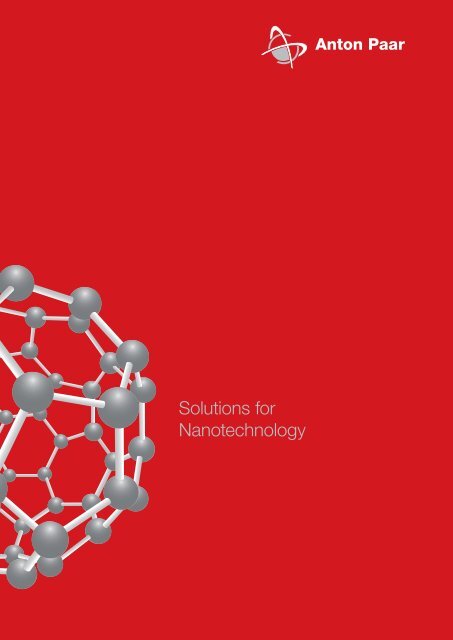
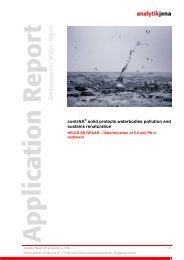
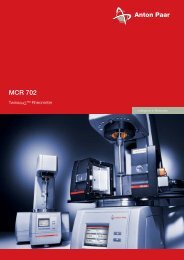
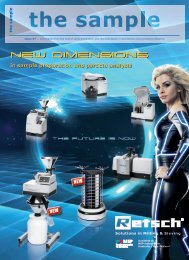
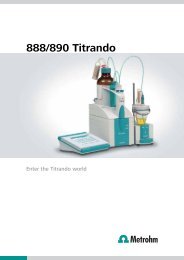
![Rice, size measurement of broken grains [pdf] - MEP Instruments](https://img.yumpu.com/46724497/1/184x260/rice-size-measurement-of-broken-grains-pdf-mep-instruments.jpg?quality=85)
